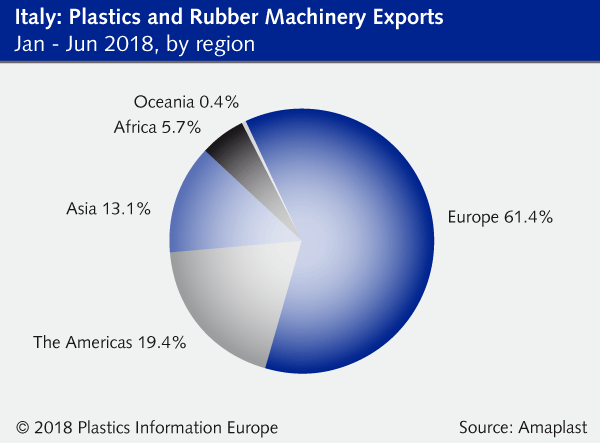PLASTICS MACHINERY ITALY
Trade balance drops in first half of 2018 / Weaker sales in Middle East / Optimism for year-end results
Italian imports of plastics and rubber processing machinery witnessed a 23% increase in the first half of 2018 compared to the same period in 2017, according to plastics and rubber machinery association Amaplast (Milan / Italy; www.amaplast.org). Based on data from the Italian National Institute of Statistics (Istat, Rome; www.istat.it), the association noted H1 values were in contrast to the "lacklustre" performance earlier in 2018. The trade balance has fallen by over 7%.
According to machinery categories, the greatest gains were recorded for imports of injection moulding (up 31%) and blow moulding (up 75%) machines, accompanied by flexographic printers (up 111%) and moulds (up 12%). Amaplast attributes some of the good performance to the uptrend in Italy's packaging industry, which is the main consumer of plastic raw materials and processing machinery.
Data from the Italian packaging machinery manufacturers association Ucima (Baggiovara; www.ucima.it) support this – domestic packaging companies witnessed over 14% growth in 2017. In line with this, the domestic mineral water and beverage industry saw positive developments last year, with PET up 7% – see Plasteurope.com of 29.03.2018. Results for 2018 are also expected to show growth.
Germany remained the top supplier for the Italian plastics and rubber processing industry. From January to June 2018, it improved its leading position ahead of China, compared to the same period in the prior year. Germany also remains the top destination for Italian exports of machinery, equipment and moulds for plastics and rubber.
According to machinery categories, the greatest gains were recorded for imports of injection moulding (up 31%) and blow moulding (up 75%) machines, accompanied by flexographic printers (up 111%) and moulds (up 12%). Amaplast attributes some of the good performance to the uptrend in Italy's packaging industry, which is the main consumer of plastic raw materials and processing machinery.
Data from the Italian packaging machinery manufacturers association Ucima (Baggiovara; www.ucima.it) support this – domestic packaging companies witnessed over 14% growth in 2017. In line with this, the domestic mineral water and beverage industry saw positive developments last year, with PET up 7% – see Plasteurope.com of 29.03.2018. Results for 2018 are also expected to show growth.
Germany remained the top supplier for the Italian plastics and rubber processing industry. From January to June 2018, it improved its leading position ahead of China, compared to the same period in the prior year. Germany also remains the top destination for Italian exports of machinery, equipment and moulds for plastics and rubber.
 | |
Europe was the main region for Italian exports in this sector in H1 2018 with a 61% share, which is relatively unchanged (up 0.7%) compared to H1 2017. Amaplast says there was a 32% drop in sales to Russia during this time. North America was the second place destination for Italian exports, and among the Americas, the Central and South American markets witnessed an overall contraction. A slowdown in Asia (6% decrease) was mainly from weak sales in the Middle East, according to Amaplast. In Africa, a 23% increase was due to higher sales both to Mediterranean and sub-Saharan countries. There was a weakening (down 21%) of the already modest level of Italian exports to Oceania.
Regarding the categories of goods, export growth was observed for all the main types of primary machinery and moulds, which together account for over half of the sector’s sales abroad. Exports remained in the black except for injection moulding machines, which have dropped by around EUR 14m.
With ordering, Amaplast president Alessandro Grassi said there is a slight trend toward improvement. This makes the association optimistic about a rebound in Italian production and exports in the last quarter of 2018.
27.09.2018 Plasteurope.com [240722-0]
Published on 27.09.2018

 German version of this article...
German version of this article...